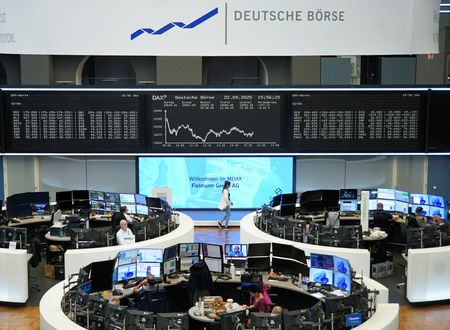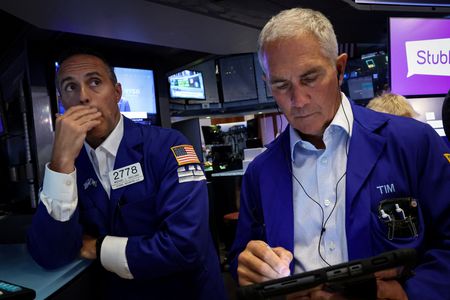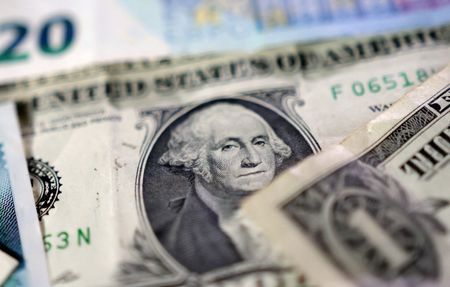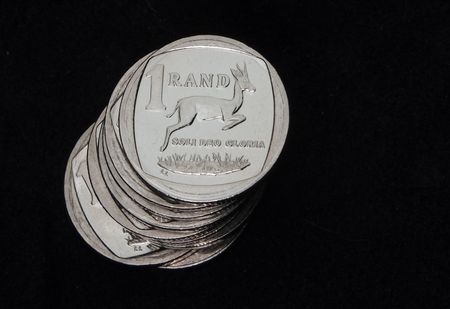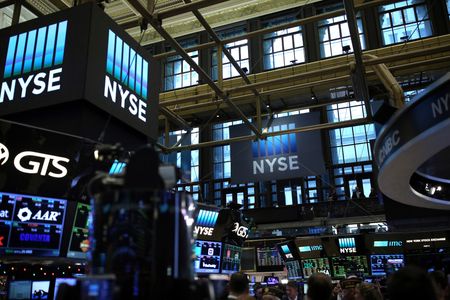By Naomi Rovnick and Rae Wee
LONDON, SINGAPORE (Reuters) -Anxiety rippled across previously buoyant global markets on Friday, as traders cautiously awaited U.S. inflation data, while fresh White House tariffs on pharmaceuticals weighed heavily on Asian bourses and public financing concerns weighed on sterling.
MSCI’s index of global stocks headed for its first weekly loss in four after U.S. President Donald Trump unveiled 100% duties on imported branded drugs as well as new tariffs on goods from trucks to kitchen cabinets.
A broad gauge of Asian shares outside Japan closed 1.4% lower, led by falls in South Korea and Hong Kong as Japanese stocks closed flat and mainland Chinese shares lost almost 1%.
Europe’s regional STOXX 600 share index traded 0.3% higher as major European drugmakers like Roche and Novo Nordisk recovered from initial losses and traders sought shelter from U.S. interest rate uncertainty in euro zone assets.
Ahead of the latest reading of the U.S. personal consumption expenditures (PCE) index later in the day, which functions as a key component of the Federal Reserve’s inflation outlook, euro zone bonds also outperformed Treasuries.
Wall Street’s benchmark S&P 500 share index has notched up 25 record closing highs over the past three months as rate cut fervour combined with a wave of fresh enthusiasm for AI stocks and investors backed out of international markets.
Ahead of U.S. bourses opening for cash trading on Friday however, futures markets indicated the S&P 500 would trade sideways and the tech-heavy Nasdaq 100 would inch 0.1% lower, leaving both indexes flat for the week.
FED RATE CUT BETS RECEDE
“You’re not getting that scenario where hard economic data is flowing through to confirm (U.S.) rate cuts,” Premier Miton fund manager Daniel Hughes said.
On Thursday, U.S. second quarter economic growth data was revised sharply higher to a 3.8% annualised rate, from 3.3% previously, and a slight drop in weekly jobless claims signaled the labour market was strengthening.
Germany’s 10-year Bund yield, which falls as the price of the benchmark euro zone debt security rises, was down 2 basis points (bps) at 2.756% as the equivalent U.S. Treasury yield was stuck at 4.1736%, close to its highest so far this month.
After the U.S. central bank lowered borrowing costs by 25 bps last week, new Fed appointee and Trump ally Stephen Miran pressed for ongoing cuts to prevent labour market collapse but multiple other Fed policymakers expressed caution on inflation.
Traders are pricing in about 39 basis points worth of rate cuts by December, compared to more than 40 bps earlier this week..
STERLING REMAINS UNDER PRESSURE
Stress in UK markets persisted on Friday as sterling headed for its biggest weekly decline in two months as it traded at $1.3348, the lowest level since early August.
UK gilts broke out of their usual negative feedback loop with sterling, with the yield on the benchmark 10-year UK debt security dropping 4 bps to 4.729%.
Benchmark UK borrowing costs hit their highest since early July in the prior session, pressuring the UK’s strained public finances because rising debt yields compromise finance minister Rachel Reeves’ ability to stick to self-imposed fiscal rules.
With the next UK Budget in November analysts are already speculating about how Reeves may seek out fresh sources of revenue, with Deutsche Bank analysts on Friday suggesting she may end a long-term freeze on petrol duties.
This, they said, could be inflationary and would require “tighter monetary policy that reduces growth.”
Elsewhere in markets, the dollar was steady against a basket of major currencies including the euro and the yen but was on track for a 0.8% weekly gain and its best performance on this measure since late July, as Fed rate cut hopes receded.
The yen languished near the 150-per-dollar level and was headed for a weekly fall of more than 1%, while the euro last bought $1.1673.
In commodities, Brent crude oil futures headed for a more than 4% gain on the week, buoyed by robust U.S. growth data.
Safe haven gold which hit an all-time peak of $3,790 an ounce earlier this week, had drifted back to $3,750 by the end of the European morning on Friday.
(Reporting by Naomi Rovnick. Additional reporting by Rae Wee; Editing by Kate Mayberry, Stephen Coates, Aidan Lewis and Chizu Nomiyama )

